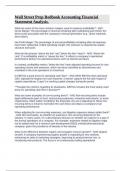Wall Street Prep Redbook Accounting Financial
Statement Analysis.
What are some of the most common margins used to measure profitability? - ANS
Gross Margin: The percentage of revenue remaining after subtracting just COGS, the
direct costs associated with the company's revenue generation (e.g., direct materials,
direct labor).
Net Profit Margin: The percentage of accrual profitability remaining after all expenses
have been subtracted. Unlike operating margin, this measure is impacted by capital
structure and taxes
What do the phrases "above the line" and "below the line" mean? - ANS "Above the
Line": If a profitability metric is "above the line," it reflects a company's operational
performance before non-operational items such as interest and taxes
In contrast, profitability metrics "below the line" have adjusted operating income for non-
operating income and expenses, which are items classified as discretionary and
unrelated to the core operations of a business
Is EBITDA a good proxy for operating cash flow? - ANS While EBITDA does add back
D&A, typically the largest non-cash expense, it doesn't capture the full cash impact of
capital expenditures ("cape") or working capital changes during the period.
***Despite the criticism regarding its drawbacks, EBITDA remains the most widely used
proxy for operating cash flow in practice***
What are some examples of non-recurring items? - ANS Non-recurring items include
legal settlements (gain or loss), restructuring expenses, inventory write-downs, or asset
impairments. Often called "scrubbing" the financials, the act of adjusting for these non-
recurring items is meant to normalize the cash flows and depict a company's true
operating performance.
When adjusting for non-recurring expenses, are litigation expenses always added back?
- ANS Not necessarily, as whether an expense is non-recurring depends on the
industry. In many cases, it's a discretionary decision on whether an expense is a part of
the normal operations of a company. For example, expenses related to litigation might
not be added back for a research and development (R&D) oriented pharmaceutical
company, given the prevalence of lawsuits in the industry
What is the difference between organic and inorganic revenue growth? - ANS Organic
Growth: A company experiencing organic growth is expanding to new markets,
enhancing its sales & marketing strategies, improving its product/service mix, or
introducing new products. The focus is on continuously making operational
, improvements and bringing in revenue (e.g., set prices more appropriately post-market
research, target right end markets).
Inorganic Growth: Once the opportunities for organic growth have been maximized, a
company may turn to inorganic growth, which refers to growth driven by M&A. Inorganic
growth is often considered faster and more convenient than organic growth. Post-
acquisition, a company can benefit from synergies, such as having new customers to
sell to, bundling complementary products, and diversification in revenue.
How does the relationship between depreciation and cape shift as companies mature? -
ANS As a company begins to mature and its growth stagnates, a greater proportion of
its total cape will shift towards maintenance.
What is working capital? - ANS The working capital metric measures a company's
liquidity and ability to pay off its current obligations using its current assets.
In general, the more current assets a company has relative to its current liabilities, the
lower its liquidity risk.
Current liabilities represent payments that a company needs to make within the year
(e.g., accounts payable, accrued expenses), whereas current assets are resources that
can be turned into cash within the year (e.g., accounts receivable, inventory)
Why are cash and debt excluded in the calculation of net working capital (NWC)? - ANS
In practice, cash and other short-term investments (e.g., treasury bills, marketable
securities, commercial paper) and any interest-bearing debt (e.g., loans, revolver,
bonds) are excluded when calculating working capital because they're non-operational
and don't directly generate revenue.
Is negative working capital a bad signal about a company's health? - ANS Further
context would be required, as negative working capital can be positive or negative. For
instance, negative working capital can result from being efficient at collecting revenue,
quick inventory turnover, and delaying payments to suppliers while efficiently investing
excess cash into high-yield investments.
However, the opposite could be true, and negative working capital could signify
impending liquidity issues. Imagine a company that has mismanaged its cash and faces
a high accounts payable balance coming due soon, with a low inventory balance that
desperately needs replenishing and low levels of AR. This company would need to find
external financing as early as possible to stay afloat
What does change in net working capital tell you about a company's cash flows? - ANS
The change in net working capital is important because it gives you a sense of how
much a company's cash flows will deviate from its accrual-based net income




